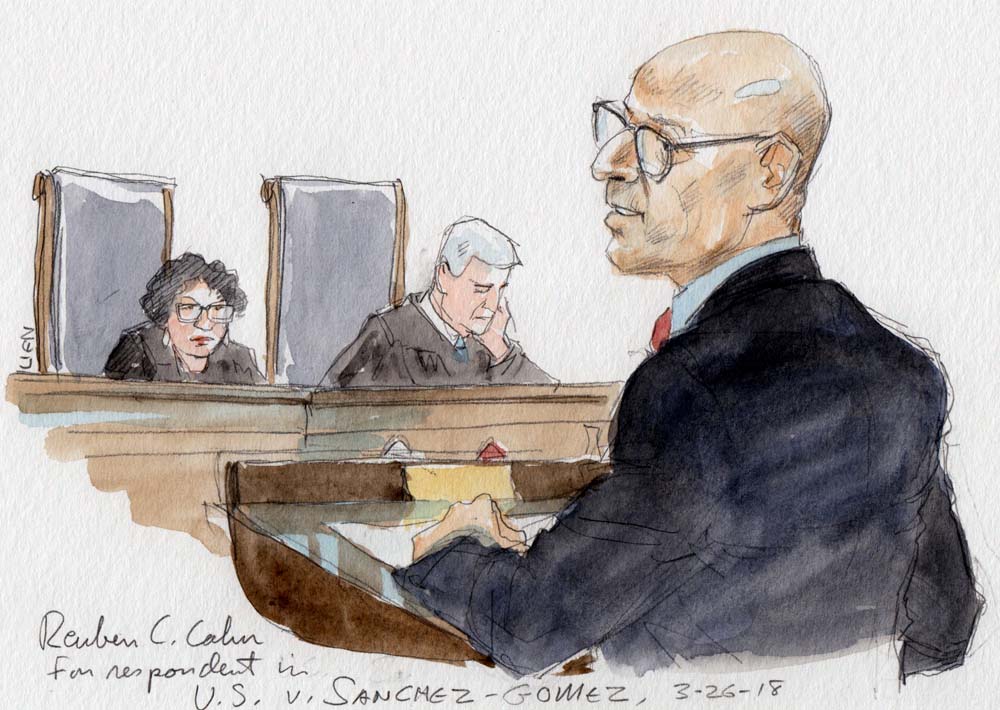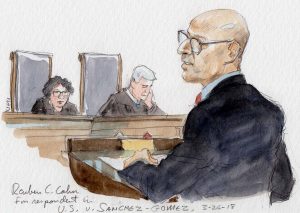Argument analysis: “Bound and gagged in body armor, hung upside down” — considering reviewability of shackling decisions


Monday’s argument in United States v. Sanchez-Gomez featured an active bench asking probing questions of both sides and allowing the attorneys to offer lengthy answers. The Supreme Court appeared to lean toward the challengers on questions of immediate appellate review of a district-wide U.S. Marshals policy that allows five-point shackling of all defendants in all non-jury proceedings, with no individual determinations of necessity.

Arguing for the United States, Assistant to the Solicitor General Allon Kedem faced early questions from Justices Anthony Kennedy and Elena Kagan about immediate review under the collateral-order doctrine, and whether review after conviction was unavailable because shackling did not affect the trial. This triggered the first of several exchanges about the challengers’ claimed constitutional violation — whether it was the effect of shackling on their criminal proceedings (which could be challenged on appeal from conviction) or a stand-alone independent deprivation of liberty from being shackled without cause (which cannot, because it is unrelated to the results of the proceeding). In later questioning from Justice Stephen Breyer, Kedem distinguished shackling from bail decisions (which are immediately reviewable), arguing that shackling for a few minutes or hours involves a shorter and less significant deprivation of liberty than does requiring a defendant to remain in jail for the duration of the criminal proceeding. Kedem insisted that “the final judgment rule has its most ardent application in the criminal context,” given the disruption in proceedings caused by immediate review.
Breyer worried that the government’s argument would preclude all review of orders restraining defendants in court. Thus, if the marshals’ office instituted a policy “that people will come in bound and gagged in body armor, hung upside down,” a person “in this country” would have no way of challenging that order. Kedem urged the Supreme Court to look for other ways to allow individuals to challenge shackling decisions besides collateral-order review. One option was a civil class action against the marshal for injunctive relief; in response to a question from Kennedy, Kedem conceded that such a class action would not become moot as new defendants subject to shackling became part of the class. Justice Sonia Sotomayor claimed never to have heard of a class action interfering with a pending criminal case; Kedem argued that it would be permissible if the suit challenged the general shackling policy rather than a case-specific shackling decision. Alternatively, he urged, the court could exercise its rulemaking power to issue a rule of procedure authorizing interlocutory appeals of shackling and similar orders, rather than relying on the judge-made collateral-order doctrine.
Kedem argued that the “most straightforward way” for the Supreme Court to resolve the case was on mootness grounds. He explained to Justice Ruth Bader Ginsburg that the case was moot because each defendant’s criminal case had ended and none had appealed. The likelihood that some defendants would commit crimes, be caught and prosecuted, and again be subject to shackling did not render the cases “capable of repetition yet evading review” (thus not moot), because “this Court has consistently refused to allow a litigant to keep a controversy alive by making a prediction of his future criminality.” Chief Justice John Roberts pointed out that in this case, the prediction had come true: Two of the challengers were arrested and shackled again. Kagan emphasized that arrests and prosecutions for unlawful re-entry to the United States by persons previously deported (the crimes at issue here) involve “extremely high levels of recidivism.” But Kedem responded that the court has been unwilling to assume that litigants will flout valid laws to become parties to criminal proceedings who are subject to case-management rules and orders.
Arguing for the challengers, Reuben Cahn of the San Diego federal defenders argued that the court of appeals could review the “extraordinary” policy of shackling every defendant at every proceeding either under the collateral-order doctrine or via extraordinary writ of mandamus. Cahn rejected the government’s suggestion that the challengers had changed their theory, insisting that they had argued all along that the policy deprived them of the fundamental right to be free of restraints.
Breyer asked Cahn to respond to the government’s argument that the defendants had three ways to challenge the policy besides collateral-order review — appeal of the conviction, writ of mandamus or civil action. Cahn argued that none was sufficient: Deprivation of the liberty interest in freedom from restraint is not reviewable on a final judgment and the Supreme Court has never held that the opportunity to pursue civil litigation in a separate proceeding is relevant to the availability of review in the underlying criminal proceeding. He later argued that an injunction interfering with the conduct of criminal cases was “not a favored course of action.” Roberts urged Cahn to acknowledge the benefit of the government’s concession that the class action would not become moot as new criminal defendants were shackled and became part of the class.
Cahn then engaged with Kagan about when a writ of mandamus might issue — whether because the issue is “super important” or only because the “outcome is super clear,” with Kagan suggesting it is the latter. Cahn argued that mandamus can be issued for a “fundamental unresolved question about the authority of the district court,” which captures this case, in which the challengers argued that the district court had no authority to shackle all individuals without making an individualized determination.
Justice Neil Gorsuch pushed Cahn to explain the challengers’ reliance on mandamus and the capable-of-repetition exception to mootness before the Supreme Court, even though the U.S. Court of Appeals for the 9th Circuit panel grounded jurisdiction on the collateral-order doctrine and the en banc 9th Circuit avoided mootness on the theory that the challengers presented a “functional” class action. Cahn backed away from both of those rationales, explaining that mandamus was the “better route” to get to the court of appeals and that capable-of-repetition was a “simple, clear route” that did not “ask this Court to break new ground.” Gorsuch found the answer “helpful.”
Justice Samuel Alito asked whether a challenge to shackling occurring at the jail, as distinct from in the courtroom, would be immediately reviewable; Cahn conceded that it would not. When Alito asked for a distinction between those situations, Cahn found meaning in the fact that the shackling occurs in court, a “sacred space” that judges control to ensure protection of litigant dignity, autonomy and liberty. There followed a lengthy exchange with the chief justice about the government’s interests in the shackling policy.
Kennedy brought Cahn back to mootness and capable-of-repetition, saying it was difficult for the Supreme Court, “as a matter of the dignity of the law,” to presume a person will violate the law. But Cahn argued that no such presumption was necessary; “the most likely evidence that something can happen is that it has happened,” as it did in the case of some of these challengers. Kagan suggested this would require different analysis for somebody with a very long rap sheet compared with a first offender. Cahn responded that when conducting mootness analysis, the court must always look at individual cases and litigants to determine whether a violation is capable of repetition. He argued that repetition was especially likely in the case of one defendant, a disabled Iraqi war veteran with severe and chronic post-traumatic stress disorder who came into conflict repeatedly with the Veterans Administration.
Kedem began his rebuttal by “pausing to just acknowledge the breadth” of the challengers’ argument in three respects — that every decision to use restraints (and likely other case-management decisions) is subject to immediate review, that compliance with circuit precedent justifies mandamus relief, and that a litigant can point to his own likelihood of committing future crimes to keep his case alive.
Posted in Merits Cases
Cases: United States v. Sanchez-Gomez